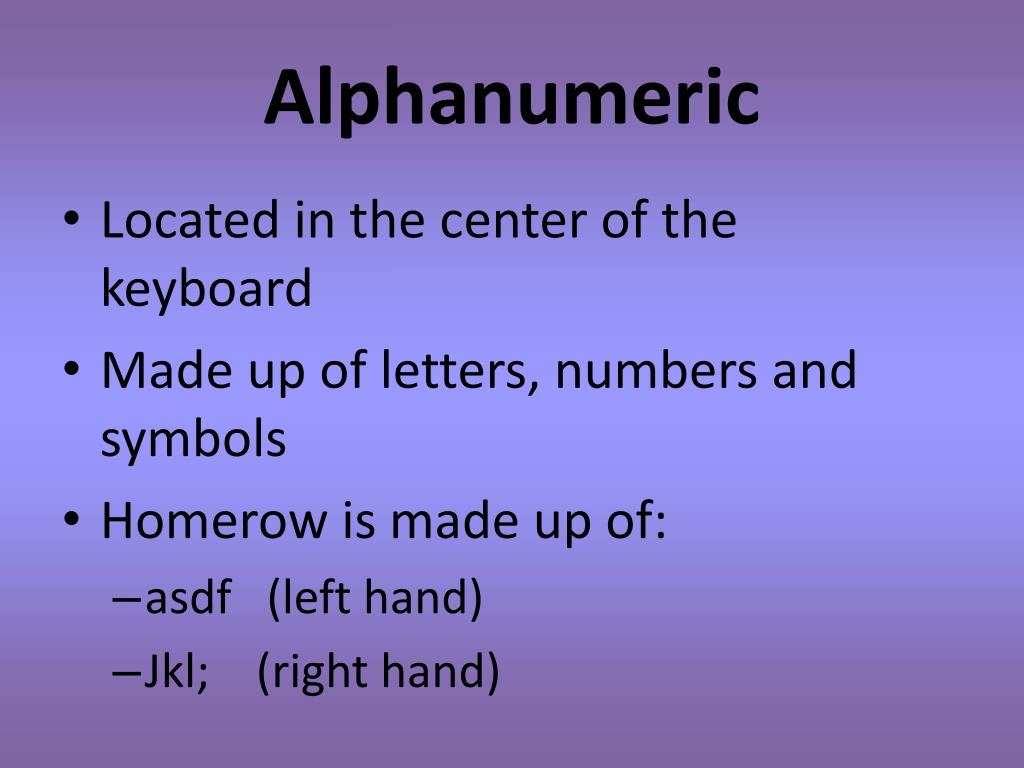

If you want to test your normal document typing, a program like Typingmaster will do nicely. I wanted to see how I typed with pure numbers with the ability to backspace, and many online tests either test with the other keys (+, -, *.) or else not allow backspacing). KSPH, however, is harder to find, especially if you need to test a particular style (i.e. So long as it tests you by having you type out a document, you will get a proper WPM. If you want to test your WPM, there's plenty of typical typing tests that do just that.
As others have said, the way you type a document (WPM) is MUCH faster than the way you perform data entry (KSPH). Since you have a KPH from your employer then that gives you both sides of the coin in a much more accurate fashion.įor those looking through this thread to convert WPM into KSPH and the reverse (since this is the first link on Google), you can't use the conversion to just take your WPM while doing a normal typing test and turn it into KSPH.
#ALPHANUMERIC KEYSTROKES PER HOUR TEST SOFTWARE#
Google "free online typing speed test" and you'll find some you can try or you can find some software for this. The KPH - WPM mathematical conversion suffices for a very broad ballpark estimation but if you want to know for sure then take a typing test. The exact type of data you're entering can have a pretty drastic impact on your speed. When I quit that job I'd been doing data entry full-time for nearly 10 years and was averaging 22,000 - 24,000 KPH. My speed dropped down to about 17,000 KPH. Then I moved to more alphanumeric entry using both the keyboard and 10 key side bar. After a year of that I was routinely averaging (for a day) 35,000 - 40,000 KPH. When I did data entry I started on purely 10 Key (working a Proof machine in a bank). Even if you are using a 10 Key side bar then moving between the keyboard and the 10 Key will affect your speed too.

If you're using the numbers on your keyboard (as opposed to a 10 Key side bar) then this will further affect your typing speed when compared to a WPM test. And, as often as not, data entry is much more alphanumeric (i.e.: data entry usually has more numerical data but still has alphabetic) than typing. This means that you type in short bursts instead of a more continuous flow like you tend to do when typing, for instance, a letter (or a forum post). Most data entry (at least what I've done) is field based.
#ALPHANUMERIC KEYSTROKES PER HOUR TEST SERIES#
The reason data entry is usually measured in KPH is that it's usually not a series of words that are being typed. Are you sure this is correct?One problem with converting from KPH to WPM is the difference in keying methods between data entry and typing. I'm a little slow when it comes to math, and I can't analyze the formula. The highest I've personally ever seen is 15,000. So, I calculated the inverse of 80 wpm (which I believe I'm somewhere near) and according to this formula that would be about 24,000 which I'm pretty sure is completely inhumanely possible. According to this formula, that makes me about 40 wpm. I have been typing about 12,000 kph (per my employer), and I'm in the top 3 of my division.


 0 kommentar(er)
0 kommentar(er)
